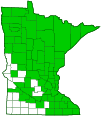gray treefrog
(Dryophytes versicolor)
Conservation • Description • Habitat • Biology • Distribution • Taxonomy
Conservation Status |
|
|||||||
| IUCN Red List | LC - Least Concern |
|||||||
| NatureServe | N5 - Secure S5 - Secure |
|||||||
| Minnesota | not listed |
|||||||
Description |
||
Dryophytes is a genus of small treefrogs. Only two species occur in Minnesota, gray treefrog and Cope’s gray treefrog. The two species are almost identical in appearance, and are difficult to tell apart in the field, even by experts. The most reliable ways to distinguish between them is by listening to their calls or by examining their chromosomes under a microscope. However, the chromosomes are normally invisible under a light microscope. They become visible only when the cell duplicates. Gray treefrog is a small, solitary, nocturnal frog. It is 1¼″ to The upper (dorsal) surface is warty. There are usually dark blotches outlined in black. The background color can change in seconds from green, light grayish-green, gray, brown, or dark brown. The color is determined by the color of the background, the season, and the humidity. It is most often some shade of gray. There is usually a large, irregular, dark blotch on the back. Beneath each eye there is a small spot. The spot is white or another light color, and it may be prominent or obscure. The belly is white. On females the chin is pale olive-gray. On males the chin is darker gray. The toes end in large adhesive pads. On males, the lower (ventral) side of the hind legs is bright yellow or yellowish-orange. |
||
Voice |
||
A slow trill lasting 1 to 3 seconds, not varying in pitch |
||
Size |
||
1¼″ to |
||
Similar Species |
||
Cope’s gray treefrog (Dryophytes chrysoscelis) is almost indistinguishable morphologically. The dorsal surface is not as rough and is more often unblotched. If blotched, the blotches are often not outlined in black. The call of Cope's gray treefrog is a faster trill with about twice as many notes. They prefer more open habitats, including prairies and savannas. |
||
Habitat |
||
Forest edges, wooded areas near permanent or temporary waters. Near street lamps and lighted buildings at night. |
||
Biology |
||
Behavior |
||
Adults are usually found high in trees, on mossy or lichen-covered fences, or sometimes in abandoned bird houses. They are rarely found on the ground except in breeding season. During breeding season the adult’s background color is usually green. |
||
Lifespan |
||
Unknown. Probably 5 to 7 years. |
||
Life Cycle |
||
Breeding occurs from April to July, peaking in May to June. After breeding, the female will deposit 450 to 600 packets of 30 to 40 eggs each on emergent vegetation at the surface of a shallow pond or a permanent or temporary pool. The eggs hatch in about three weeks and metamorphosis occurs about four weeks later. The tadpole is about 2″ long preceding metamorphosis. Adults live 5 to 7 years. They overwinter under the shelter of a log, rock, bark, or leaf litter. They are freeze tolerant and can survive multiple freeze-thaw cycles. Glycerine is produced preventing the formation of ice crystals in vital organs. |
||
Tadpole Food |
||
Algae, material from dead and decaying plants and animals (detritus). |
||
Adult Food |
||
Insects, insect larvae, mites, spiders, plant lice, harvestmen, snails, and smaller frogs. |
||
Distribution |
||||
|
Sources |
|||
| 8/29/2023 | ||||
Occurrence |
||||
Common |
||||
Taxonomy |
|||
| Class | Amphibia (amphibians) | ||
| Superorder | Batrachia (amphibians) | ||
| Order | Anura (frogs and toads) | ||
| Suborder | Neobatrachia | ||
| Superfamily | Hyloidea | ||
Family |
Hylidae (tree frogs and allies) | ||
Subfamily |
Hylinae | ||
Genus |
|||
Gray treefrog and Cope’s gray treefrog were, until 1968, considered the same species. The genus Dryophytes was originally described in 1843. In 1882 all Dryophytes species were transferred to the genus Hyla, which then contained all treefrog species in the Northern Hemisphere. In 2014 North American species were placed in the new subgenus Dryophytes. In 2016 the subgenus was raised to genus level, resurrecting the original genus. Today, the genus Hyla now contains only Old World species. All North American treefrog species, and three species in temperate eastern Asia, now belong to the genus Dryophytes. The last move was not universally accepted. |
|||
Synonyms |
|||
Dryophytes versicolor phaeocrypta Dryophytes versicolor versicolor Hyla versicolor |
|||
Common Names |
|||
chameleon treefrog common gray treefrog eastern gray treefrog gray treefrog |
|||
Visitor Photos |
|||||
Share your photo of this amphibian. |
|||||
| This button not working for you? Simply email us at info@MinnesotaSeasons.com. Attach one or more photos and, if you like, a caption. |
|||||
Alfredo Colon |
|||||
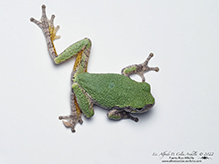 |
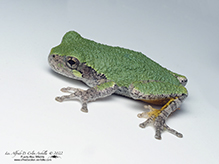 |
||||
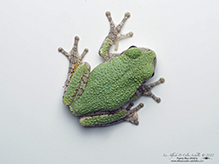 |
|||||
Jeff LeClere |
|||||
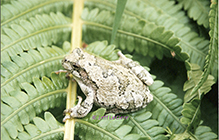 |
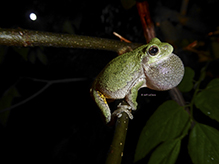 |
||||
MinnesotaSeasons.com Photos |
|||||
|
|||||

Slideshows |
||
Dryophytes versicolor (Eastern Gray Treefrog) |
||
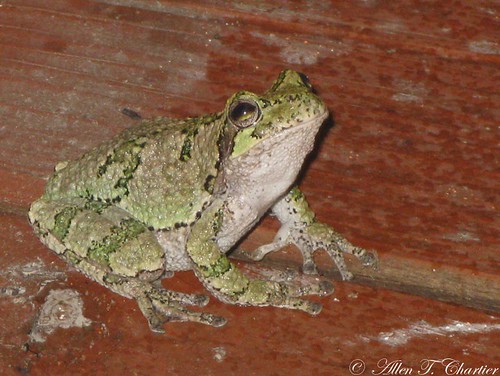
|
||
Dryophytes versicolor |
||
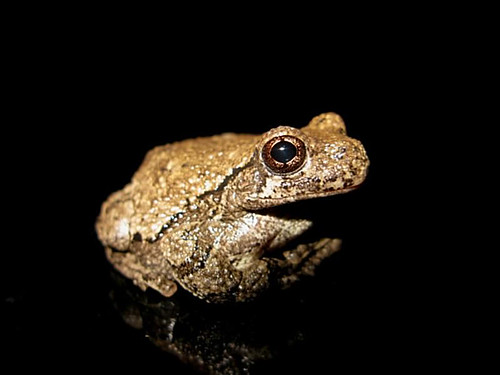
|
||
About
Gray Treefrog |
||

Visitor Videos |
|||
Share your video of this amphibian. |
|||
| This button not working for you? Simply email us at info@MinnesotaSeasons.com. Attach a video, a YouTube link, or a cloud storage link. |
|||
Other Videos |
|||
| Gray Treefrog & Cope's Gray Treefrog (Dryophytes versicolor & Dryophytes chrysoscelis) WisCBMnetwork |
|||
About
Published on Apr 30, 2012 No description available. |
|||
| Gray treefrog calling TSTPtv |
|||
About
Published on Oct 13, 2013 Did you ever want to know what a Gray treefrog (Dryophytes versicolor) sounds like? |
|||
| Gray/Grey treefrog (Dryophytes versicolor) calling: Video Ryan M. Bolton |
|||
About
Uploaded on May 23, 2007 Gray treefrog calling. |
|||
| Eastern gray treefrog calling HerpNet |
|||
About
Uploaded on Mar 20, 2009 Eastern gray treefrog calling |
|||


Created 6/19/2006
Last Updated:
